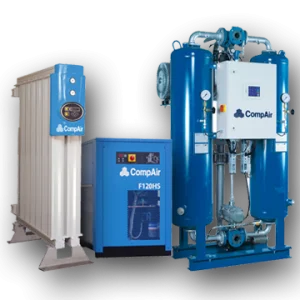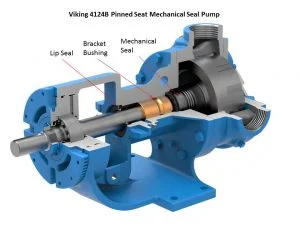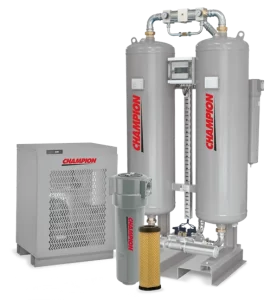
There are really only two ways to make a profit in business. Reduce your costs of production or Sell more of your products. The president of your company and your CFO are not doubt admonishing you to cut costs as much as you can.
I’m sure you’ve shared the same mission with your team. One of the biggest opportunities to cut costs is to reduce power consumption. And one of the biggest power users of power in most production plants is:
Your Compressed Air System
Compressed Air System design is a matter of not how much you have but how well you use it. It wouldn’t be uncommon for a business to be able to cut their compressed air demands by 20% just by eliminating leaks.
Beyond that there are opportunities to get the same production for a less costs. (Or create the capacity to scale up and keep your costs constant). Here’s how you can do that
Make Sure Each Piece Of Machinery Is Receiving The Right Pressure.
Unfortunately – when individual pieces of machinery aren’t getting enough air pressure, the maintenance team often just jacks up the air pressure until the complaints go away.
With only a couple of machinery operators complaining, if maintenance increases the system pressure – then it’s a given that a lot of other machinery is going to be receiving too much air.
Best practice to avoid this problem is to divide your compressed air system into zones and use regulators so that the pressure delivered to each zone matches the demand of the machinery. Depending on the complexity of your compressed air system you might want to engage an external compressed auditor (like Pye-Barker) to help guide you through this process.
After you’ve started to manage your air flow more systematically you’ll reduce your compressed air consumption – slashing your power bills by producing less compressed air.
Invest In Storage
Most compressed air systems like to be running at a constant speed, rather than whipsawing between full-load and unloaded every couple of minutes. Depending on the size of your compressor and the storage capacity of your current system this may not be possible.
When your compressors are flip-flopping between loaded or unloaded they consume a lot of power, and incur a lot of wear and tear. If that is the case it is wise to increase the storage capacity of your system to reduce power bills and break down.
You can do this with either dedicated storage, secondary storage or even offline high pressure storage.
Optimize Air Usage
Bearing in mind that it takes between 7 and 8 horsepower to deliver one pneumatic horsepower, it might pay to switch some of your air driven machinery out for more energy efficient options and use less compressed air. For example you might be able to:-
In the end the cost of a unit of compressed air is relatively static. The value you get from your investment in your compressed air is determined by how efficiently you use the air your produce. This is why compressed air auditing is essential for any business running complex compressed air systems. This advice goes double if you are considering adding more compressors to your system to accommodate ‘increased demand.’
There are always opportunities to improve your compressed air system and bring your costs into line with best practices. If you are considering investing in more air compressors or are looking to cut costs I’d recommend starting with an AirInsite compressed air audit. To arrange yours call 404-363-6000 or drop us a line sales@pyebarker.com and we can get the ball rolling.

Despite all the advances in pump design over the years, we still have to choose how we are going to minimize leakage from our pumps. Based on our team’s observation here at Pye-Barker, there is a split between two camps. The mechanical seal camp and also the packing camp. Both have their merits depending on the circumstances and no doubt you have your own personal preferences.
I’ll deal with mechanical seals another time and focus on packing here.
From DIY options, to custom solutions to even manufacturer supplied packing systems, any pump buyer is faced with an almost bewildering number of choices.
If you want to pack a pump then there are 4 key steps.
As an authorized service center and supplier of Viking pumps for over 40 years, I want to also share with you a video by Viking on installing packing in your Viking pump.
Choosing the Right Materials.
Since we are in the risk minimization business, we want our clients to maximize up-time, minimize maintenance bills and not spend time and money reinventing the wheel… I believe there are only two sensible choices for pump packing materials. Either use the packing materials provided by the manufacturer that are recommended for your application or use a specialist third party packing supplier. We’ve been using Rainsflo Packing for years on special applications and our clients have been delighted with the results.
Site Preparation.
When replacing the existing packing make sure that the stuffing box is clean. Any debris in there can reduce the quality of the seal and increase the rate of loss from the pump.
Make sure the stuffing box isn’t heavily corroded. If it is, replacing the packing rings won’t give you the seal you desire. You’ll need to replace the worn parts in order to get the same quality seal as you’ve had before.
Correct Installation
Make sure you install your packing as per the manufacturer’s specifications. I won’t get into all of the different ways this can go wrong for you right now. Again, look for a later post on this.
Be very precise about installing your packing. If a component is off, all of your packing might be out of place and again you won’t generate the sealing you are after.
There are a couple of points I’ll address specifically here. Firstly, don’t over tighten your packing. Some product should weep out. If you do, you run the risk of burning the shaft or locking up the pump.
Then. make sure your maintenance team is also aware that packing is meant to weep some product.
Ongoing Monitoring.
During the break in and subsequent monitoring, always follow the manufacturer’s procedures. Again there is nothing worse than doing something twice because you didn’t read the manual. Be sure to allow sufficient run time after each adjustment until you have the system to adapt to your previous adjustment. Once you are happy be sure not to over tighten your packing – remember it should weep. Then continue to follow your packing manufacturer’s guidelines and your packing will have a long life with less downtime.
If you have any questions packing one of your pumps then get in touch with our team on 404-363-6000 or drop us a line sales@pyebarker.com and we will get your questions answered.

One phenomena that baffles us and our clients more often than we’d like is when our audit team’s list of “low cost quick wins” often aren’t implemented immediately.
When we check back, many clients haven’t fixed their leaks. They haven’t made simple process improvements to make sure each department that uses compressed air is receiving that air at the correct pressures. They haven’t… they haven’t…
These are simple fixes. They can save you A LOT of money and these savings can be leveraged into other improvements in the compressed air system and around the plant.
Generally the ‘low cost stuff’ is really sorting out the demand side of your compressed air system.
The reason why they don’t get followed up on can be quite simple. Your team’s priorities. I bet your team is busy. I bet they often spend more than their forty hours on the job trying to get everything done.
They don’t have time to read let alone address the findings in the auditor’s report.
In order to capture those improvements in your plant – you need a plan.
Here is how I would attack the challenge of my demand side savings:
Run It As A Project.
You’ve got a goal to capture savings. And to prove this project has paid off you need to be able to measure before and after. You’ve got a set of milestones in your report – you could call them your project deliverables. We prioritize these opportunities (calculate the biggest savings opportunity and make it priority one etc.) for clients in our compressed air audits. Other auditors do not. Lack of clear priorities can be a problem when you are getting started.
You know the project is done when all of those savings opportunities have been captured. Finally once you’re done you can measure the before and after and count the dollars in the bank.
Measurement.
While you are planning your project, get your measurement plan in place. Here at Pye-Barker we have the expertise to measure and manage the installation of a metering system. Be sure to meter your supply side and also the opportunity areas on your demand side.
Tackle Priority One.
Now that we have our measurement in place, we can figure out how we can slash the demand on project priority one. It might be a zone in your compressed air system where you’ve identified some major leaks. Your project manager can work with the appropriate team members to identify and then fix all of the tasks associated with completing this phase of the project.
Then you should be able to do a ‘before and after’ comparison of compressed air and power consumption. And work out the return on your investment.
Repeat for the remaining opportunities.
Plan your next phase, find and fix. Compare your before and afters.
Project management can be as hard or as easy as you want it to be. Generally simpler is better. Be clear about your objectives and be sure you can show a result. Nothing talks more clearly than results.
All compressed air savings plans start with a comprehensive compressed air audit. Pye-Barker has been helping all types of compressed air users get the best return on their compressed air systems with our thorough Compressed Air Auditing system. You can find out more about our compressed air audits by calling 404-363-6000 or emailing sales@pyebarker.com
In December, I shared with you 3 Air Operated Diaphragm Pump (AODD) installation traps. There are another 3 common installation traps that I see maintenance teams make when installing them.
I thought I’d share these with you here to save you the time and hassle of having to wait until something stops working on your AODD pumps to go and troubleshoot it and fix it.
A lot of plants choose to use AODD pumps when self-priming is required. If you just switch the air flow from off to the required flow rate, you may find that there is not enough time for the fluid to be drawn into the pump to prime it…
This can be avoided by just turning down the compressed air at the regulator for a few seconds – letting the pump work at the reduced pressure – which allows it to draw the fluid into the pump and prime it.
Then you can turn the pump back to full operating speed.
AODD Pump Installation Trap #2: Ensure Your Tubing and Piping Is The Correct Size
The inlet and outlet ports on your pump are selected based on the flow rate you specify. Make sure your inlet and outlet hoses match the pump’s ports.
The main reason is cavitation. Too little flow to the pump and you’ll end up with cavitation which can ruin a pump in no time flat – leading to costly downtime and repairs. Getting the pipes to match the flow rate is worth the fraction of extra investment upfront to avoid the future problems.
Also – I’d recommend using flexible inlet/outlet piping rather than hard plumbing the pump in. As the pump speed increases the vibration increases which elevates the risk of loosening hard plumbed inlets/outlets – creating a risk of leaks forming.
AODD Pump Installation Trap #3: Clear Fluid Line Restrictions During Maintenance.
Honestly, you’d be surprised how often this step gets missed. We get called in on pumps that have broken down and find all sorts of restrictions in the fluid line. We point this out to the client and they mumble something like - “The maintenance team is supposed to look after that.”
If you’ve got a problem with your maintenance team cutting corners, be sure to inspect them – find out who’s doing their job and who isn’t. Also, it’s not hard for a maintenance supervisor to listen for the tell-tale sound of gravel in the pump or flashing around the manifold elbows which indicate cavitation.
Make sure your maintenance team is checking for
Doing your maintenance is like going to the gym for most people… We hate doing it but we feel better afterwards. If you have any questions about your existing air-operated diaphragm pumps then get in touch with our team on 404-363-6000 or drop us a line sales@pyebarker.com and we can get your questions answered.


